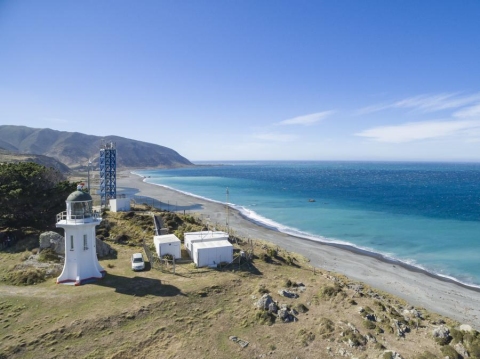CarbonWatchNZ will address crucial carbon cycle questions in the three landscapes that are most important to New Zealand’s carbon balance: forest, grassland and urban environments. It will measure and assess our two main greenhouse gases – CO2 and methane.

Estimating greenhouse gas emissions and absorption
By combining measurements of greenhouse gases in the air above New Zealand with high resolution weather models that show where those gases have come from, CarbonWatchNZ will develop a complete top-down picture of our country’s carbon balance. This is known as an inverse modelling approach.Simulations from a land model and ocean carbon data will provide additional information. CarbonWatchNZ is addressing crucial carbon cycle questions in the landscapes that are most important to New Zealand’s carbon balance: indigenous and exotic forests, farmland and urban environments. It will measure our two main greenhouse gases – carbon dioxide (CO2) and methane (CH4), as well as other gases that will help us understand processes.
Improving accuracy through a different approach
Greenhouse gas emissions and uptake have traditionally been estimated using methods known as bottom-up. For example, carbon dioxide emissions from transport are estimated based on the amount of fuel burnt by New Zealand vehicles and information about emission rates for different fuels. Forest carbon uptake is estimated by measuring changes in the circumference of trees in sample plots all over the country, combined with forest height and land cover information and scaled up across the country. While these methods are valuable for creating inventories, they don’t capture everything. For instance, measurements of the circumferences of trees in a forest may not capture carbon emissions and uptake in the full forest ecosystem. By combining the top-down atmospheric observations from CarbonWatchNZ with these existing estimates from the ground up, New Zealand will have a more complete picture of our carbon balance, which will guide our carbon mitigation strategies.
Setting up a nationwide network of monitoring stations
NIWA's clean air station at Baring Head, near Wellington, has been running since 1972, and it is home to the longest running continuous CO2 measurements record in the Southern Hemisphere. Our atmospheric research station at Lauder (near Alexandra) was set up nearly 60 years ago and has been collecting greenhouse gas data since 2007. Both stations and the long-term data they have provided are critical to the success of the project.
Our newest atmospheric monitoring station, Maunga Kākaramea/Rainbow Mountain, near Rotorua, is now capturing data in the central North Island. Additional monitoring sites are being set up around Auckland, Canterbury Plains, Lake Taupo and Fiordland.
New Zealand’s unique advantages
New Zealand is an island very far from other land sources and sinks. When the wind is coming from the south, air arriving at our monitoring station at Baring Head has not been in contact with land regions for a long time. This makes it much easier to separate what is happening to greenhouse gases inside NZ from what’s happening outside.
To connect what’s going on in the atmospheric data with emissions from land areas, we need a very clear picture of what the winds are doing. New Zealand is the only country running a weather forecast model for the whole country at 1km resolution.
Indigenous and exotic forests
Forests—both indigenous and exotic—primarily act as carbon sinks, taking up carbon dioxide from the air and using this through photosynthesis to form the building blocks they need for growth.
The project will help work out the difference in carbon uptake between forests in different regions of New Zealand. It will also assess differences between indigenous and exotic forests, which will inform decisions about investing in forest planting as a means of offsetting carbon emissions.
Urban environments
A large portion of New Zealand’s greenhouse gas emissions come from our cities, primarily from carbon dioxide produced by burning fossil fuels to provide energy for transport and industry. However green areas in cities take up some of these greenhouse gases. By setting up monitoring stations around a city and matching data from this with information about wind direction, CarbonWatchNZ will be able to calculate more accurately the balance of our urban greenhouse gas emissions and uptake. Auckland is the first city we’re looking at—it already has its own Low Carbon Action Plan and is a member of the global C40 Cities Climate Leadership Group.As well as measuring CO2 and methane, monitoring other trace gases in urban areas will help us distinguish between carbon uptake and emissions from different sources. Importantly, the project will also reveal the effectiveness of efforts to reduce emissions, such as reducing petrol cars on the roads, in near real time.
Pastures and farms
Methane produced by digestive processes of farm animals is New Zealand’s other big contributor to greenhouse gas emissions. In addition, the processes that occur by soil and pasture are likely to both take up and emit greenhouse gases—and the balance of these processes is not yet understood.
CarbonWatchNZ will allow us to more accurately quantify the impact of agriculture on greenhouse gas emissions. It will also help us assess the effectiveness of measures to reduce methane emissions, such as use of food additives and vaccines.
New Zealand scientists working together to lead the way globally
CarbonWatchNZ is a collaboration between NIWA, GNS Science, Manaaki Whenua Landcare Research, Auckland Council and the University of Waikato.It is a globally recognised project that will build the world’s first national-scale picture of a country’s carbon balance. The United Nations World Meteorological Organization has highlighted New Zealand as an “exemplar” country, providing a template for other nations to follow for their own carbon reporting.
